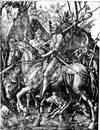Exam 1 Flashcards
know your crap lady

Giotto, Ognissanti Madonna, c. 1310

Simone Martini, Annunciation, 1333

Lorenzo Ghiberti, Gates of Paradise, 1425–55
Jacob and Esau

Donatello, St. Mark, 1411–13

Masaccio, Holy Trinity, 1425

Gentile da Fabriano, Strozzi Altarpiece, 1423

Domenico Veneziano, St. Lucy Altarpiece, 1445

Sandro Botticelli, Birth of Venus, 1480

Leonardo da Vinci, Last Supper, 1495–98

Leonardo da Vinci, Mona Lisa, 1503–05

Raphael, School of Athens, 1510–11

Michelangelo, David, 1501–04

Michelangelo, Moses, Tomb of Julius II, 1513–16

Jacopo Pontormo, Descent from the Cross, 1525–28
(Entombment)

Parmigianino, Madonna of the Long Neck, 1535

Giovanni Bologna, Rape of the Sabine Women, 1583

Giorgione/Titian, Pastoral Concert, 1508–10

Titian, Pesaro Madonna, 1526

Jan van Eyck, Giovanni Arnolfini and His Bride, 1434
Mannerism vs. Renaissance
Mannerism
Space: Crowded
Figure: Elongated, unreal
Colors: Arbitrary, unnatural, clashing
Subject: Complex, odd, twisting and strange poses
on balls of feet, unreal, makes you feel uneasy. evoking emotions and symbolism rather than being visually acurrate or possible. Twisiting of bodies.
Renaissance:
Space: Order, realistic, correct perspective
Figure: Real and accurate porportions
Colors: Natrual, harmonious
Subject: traditional, real, contropposto, natural positions
15th Century Italian South vs North
SOUTH: elegant use of flowing lines, pictorial space, and antique “revival of the nude”, inspirired by the greek and romans, heavily focused on the church, vatican. Representing holy figures in a holy way. This Italian social change and rise in humanism led a shift in power to Rome and Italian artists to consider scientific principles behind individual composition such as proportion, anatomy, and perspective. accurate anatomical proportions, even balance, and linear perspective. Wealth and noble standing. realistic art with shadows and action. “Heroes” “Ideal”. Fresco. Getting it right, not necesarrily details, focus on the figure. Controposto: dynamic, having the weight shifted, more weight on one foot than the other.
NORTH: elegent, minute attention to detail beauty in nature, the natural, common man in artwork. Movement in the daily life. Peasants. naturalism and knowledge of the self and present rather than the past. Embracing the common man. Local Landscape, peasant food and dress. Less focus on the person and more focus on a common life. s-curve, mannequin like. Medium: with oil in the north they were able to do greater detail and take their time, rather than fresco in italy. ultra realism

Grunewald, Crucifixion [from Isenheim Altar] 1510

Durer, Knight, Death, and The Devil, 1513

Bruegel, Return of the Hunters, 1565


